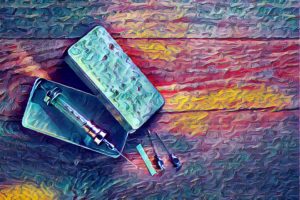
Safer Using – Benzos
About Benzos Benzodiazepines or “benzos” are a class of drugs which have sedative, sleep-inducing (hypnotic), anti-anxiety (anxiolytic), muscle relaxant and…
3-HO-PCP (also known as 3-OH-PCP or 3-hydroxyphencyclidine) is a dissociative drug in the arylcyclohexylamine class alongside PCP and ketamine.1 Notably, 3-HO-PCP is more potent than both PCP and ketamine, and has also been observed to bind to opioid receptors in rats.1,2,3,4 The implications of 3-HO-PCP’s activity on opioid receptors has not been studied in humans, but may contribute to 3-HO-PCP’s pain relieving (analgesic) effects and may have safety implications for its use as a dissociative drug and the complications associated with overdose.1,4

In recent years, various new drugs have been emerging in the drug market which are commonly called research chemicals (RCs) or designer drugs.5 The increasing prevalence of RC dissociatives, including 3-HO-PCP, 2F-DCK, and 2F-NENDCK (a.k.a. CanKet), is particularly notable.5 RC dissocatives are both specifically sought after for their unique effects and incorrectly sold as other drugs, such as ketamine.5,6,7,8 Importantly, many of these RC dissociatives, including 3-HO-PCP, have not been studied in humans and may have unexpected and/or dangerous side effects.
CanTEST is a free health and drug checking service available in Canberra. 3-HO-PCP has been detected in a sample expected to be ketamine at CanTEST.7,8 Since no one can tell the difference between white powders, it’s important to test your drug samples (dissociatives or otherwise) for the presence of adulterants before taking them. Reagent test kits can also be used to test ketamine for adulterants at home (e.g., https://dancesafe.org/product/ketamine-testing-kit/).
Multiple samples of 3-HO-PCP have been tested at CanTEST, Canberra’s free health and drug checking service. These samples were tested for the presence of fentanyl using fentanyl test strips (similar to those available here) and repeatedly tested positive for the presence of fentanyl. Gas chromatography mass spectrometry (GC-MS) is a far more accurate and sensitive measure for the presence of fentanyl than test strips. When later analysed using GC-MS, fentanyl was not detected in these samples. This suggests fentanyl test strips used on samples of 3-HO-PCP may falsely test positive for fentanyl. Keep in mind, this is speculative and has not been reported elsewhere by users or researchers. This may be investigated further, and more information will hopefully become available.
3-HO-PCP is an anaesthetic, so high doses have the potential to cause the loss of a person’s ability to move and loss of consciousness. For this reason, it is important for a person taking 3-HO-PCP to let someone else know they’ve taken it or preferably to have a trusted, sober person nearby to assist them if needed (e.g., a trip sitter).
The commonly reported effects of 3-HO-PCP include:1
It’s important to start at a low dose and to wait before redosing recreational drugs (start low and go slow). This is especially important for RCs like 3-HO-PCP that are likely to have unpredictable side effects and interactions with other substances.
The following is a rough dosage guide for 3-HO-PCP:1,9
LOW DOSE – 2-4 mg
MODERATE DOSE – 4-6 mg
STRONG DOSE – 6-8 mg
HEAVY DOSE, POSSIBLE OVERDOSE – 8+ mg
The effects of 3-HO-PCP reportedly last between 4-6 hours in total, and it likely takes significantly longer to kick in than ketamine (possibly up to 90 minutes).1
The symptoms of 3-HO-PCP overdose appear to be similar to PCP overdose, namely:9
Since 3-HO-PCP is more potent than PCP and ketamine, smaller doses of 3-HO-PCP may be more likely to cause undesirable effects or overdose when compared to PCP and ketamine. Unexpectedly high doses, particularly in an unsafe environment, can result in injury due to loss of coordination, motor control or consciousness.1 If someone has taken an unexpectedly high dose of 3-HO-PCP, encourage them to sit or lie down in a safe place, and sit with them to make sure their condition doesn’t deteriorate. If a person is struggling to maintain consciousness:
Like ketamine, mixing 3-HO-PCP with other depressants–including alcohol, GHB and opioids–is likely dangerous since the combination may greatly increase the risk of vomiting, loss of coordination, and unconsciousness.10 If someone is having a severe reaction to mixing 3-HO-PCP with another drug, seek medical attention as soon as possible.
In very severe cases, 3-HO-PCP may cause potentially fatal reactions such as:11
One severe toxic reaction and one death following use of 3-HO-PCP have been reported.9,11 In both cases, one or more other substances were used as well but 3-HO-PCP toxicity predominated.9,11 According to a toxicologist, the death was most likely due to a fatal concentration of 3-HO-PCP which caused respiratory depression.11
It is unknown whether 3-HO-PCP’s activity on opioid receptors influences its toxicity. Opioid overdose is known to cause life-threatening respiratory depression, which can be temporarily reversed using naloxone, an opioid receptor antagonist.12 Naloxone has not been studied for reversing 3-HO-PCP overdose. Administering naloxone to a person who has overdosed on 3-HO-PCP may have little or no effect, but likely won’t make their condition worse. If there’s any chance a person has also taken opioids alongside 3-HO-PCP, administering naloxone is highly recommended. If someone is having a severe reaction to 3-HO-PCP, seek emergency medical attention as soon as possible even if you have administered naloxone.
Naloxone is available for free without a prescription in Australia as part of the Take Home Naloxone program.13 Depending on the jurisdiction, it may be available at pharmacies, alcohol and drug treatment centres, needle and syringe programs, among other services. 13 Naloxone is available for free at the CAHMA drop-in centre and at CanTEST.
[1] https://psychonautwiki.org/wiki/3-HO-PCP
[2] https://doi.org/10.1016/0014-2999(81)90097-2
[3] https://doi.org/10.1021/jm00346a019
[4] https://pubmed.ncbi.nlm.nih.gov/6088255/
[5] https://doi.prg/10.1002/dta.1620
[6] https://twitter.com/CanTESTCBR/status/1673813560328167426
[7] https://twitter.com/CanTESTCBR/status/1646685300549369857
[8] https://www.reddit.com/r/canberra/comments/11kmz84/3hopcp_found_in_ketamine_sample_cantest/
[9] https://doi.org/10.1007/s13181-019-00734-x
[10] https://drugs.tripsit.me/ketamine
[11] https://doi.org/10.1093/jat/bkad031
[12] https://doi.org/10.1177/2042098614564776
[13] https://www.health.gov.au/our-work/take-home-naloxone-program/about-the-take-home-naloxone-program
Written by Darcy Lynch

About Benzos Benzodiazepines or “benzos” are a class of drugs which have sedative, sleep-inducing (hypnotic), anti-anxiety (anxiolytic), muscle relaxant and…

My name is John, and I would like to talk about some of my drug using experiences and how I…

About Nitazenes Nitazenes, also known as benzimidazole opioids, are a class of synthetic opioids which vary widely in potency.1 Some…